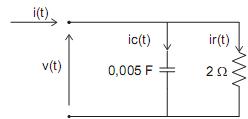Questões de Concurso
Para engenheiro de controle e automação
Foram encontradas 228 questões
Resolva questões gratuitamente!
Junte-se a mais de 4 milhões de concurseiros!

A figura mostra como é possível medir a potência reativa de uma carga em sistemas trifásicos utilizando-se wattímetros. Essa possibilidade só se concretiza se sua bobina de potencial (Bp) for alimentada com tensão defasada, referente à bobina de corrente, em relação à tensão aplicada à carga, de

A figura representa um bipolo alimentado com tensão, em volt, dada por

O fasor da corrente no bipolo é
OBS: Utilize, no cálculo, aproximações com uma casa decimal.

O diagrama de fasores acima corresponde a uma instalação elétrica de um centro de operações para supervisão e controle com as suas cargas elétricas ligadas em triângulo aterrado, com as correntes de linha equilibradas apresentando valor de 5 A, e a tensão de linha, valor de 374 V. A potência elétrica ativa na fase CN para essa instalação é:

I – O ar não tem propriedades lubrificantes e sempre contém vapor d’agua, enquanto que o óleo é lubrificante e permite transferir calor gerado no sistema para um trocador de calor conveniente.
II – As potências de saída dos sistemas pneumáticos são consideravelmente superiores às dos sistemas hidráulicos.
III – A precisão dos atuadores pneumáticos é deficiente nas baixas velocidades, enquanto que a precisão dos atuadores hidráulicos é satisfatória em todas as velocidades.
Está correto o que se afirma em
Observe as afirmações a seguir referentes à rede PROFIBUS.
I – A rede PROFIBUS é baseada em padrões reconhecidos internacionalmente, sendo sua arquitetura de protocolo orientada ao modelo de referência OSI (Open System Interconnection), conforme o padrão internacional ISO 7498.
II – A rede PROFIBUS-DP permite sistemas mono e multimestre oferecendo um alto grau de flexibilidade na configuração do sistema, com até 256 dispositivos (mestres ou escravos) podendo ser ligados a um barramento, e sua configuração consiste na definição do número de estações, dos endereços das estações e de seus I/O, do formato dos dados de I/O, do formato das mensagens de diagnósticos e os parâmetros de barramento.
III – Cada sistema de PROFIBUS-DP pode conter três tipos de dispositivos diferentes: (a) Classe-1 DP MASTER é um controlador central que troca informação com as estações descentralizadas dentro de um ciclo de mensagem especificado; (b) Classe-2 DP MASTER são terminais, dispositivos ou painéis de operação utilizados para configuração do sistema DP e também para a manutenção e diagnóstico do barramento ou de seus dispositivos; (c) DP SLAVE é um dispositivo periférico que coleta informações de entrada e envia informações de saída ao controlador.
Está correto o que se afirma em
A esse respeito, observe as afirmativas a seguir.
I – O temporizador deve ser do tipo não retentivo, isto é, se a energização for perdida, o valor acumulado é zerado.
II – O temporizador deve possuir uma entrada que, ao se energizar, habilita o acúmulo do tempo decorrido.
III – O temporizador deve possuir uma saída que será energizada quando o valor acumulado for igual ao preestabelecido, e todas as outras condições de funcionamento do elemento estiverem satisfeitas.
Está correto o que se afirma em

A potência mecânica, em HP, necessária e suficiente ao sistema hidráulico, atendendo às condições dadas, é
I – O uso de ondas de rádio em alta frequência depende de regulamentação junto aos órgãos públicos.
II – O uso de ondas de rádio em alta frequência gera problemas de autenticação junto aos usuários.
III – O uso de ondas de rádio em alta frequência está sujeito à ocorrência de interferência entre os componentes do sistema.
IV – O uso de ondas de rádio em alta frequência impossibilita a existência de unidades transceptoras móveis.
Está correto APENAS o que se afirma em
I – Ao se aplicar um pulso positivo à porta (gate) de um SCR, este continua conduzindo, mesmo que o sinal de disparo seja retirado, e assim permanece enquanto houver uma corrente mínima circulando entre anodo e catodo, chamada corrente de manutenção.
II – O IGBT é um componente eletrônico cujo controle de condução entre o coletor e o emissor é feito por tensão ao invés de corrente.
III – Um TRIAC é um elemento bidirecional, ou seja, pode conduzir nos dois semiciclos de uma senoide.
Está correto o que se afirma em
Nessa situação, o valor da tensão, em volts, à qual sub- mete-se o capacitor é

Para que o sistema seja estável, é necessário e suficiente que
Admitindo uma resistência
 uma capacitância
uma capacitância  o valor da frequência de corte, em hertz, é
o valor da frequência de corte, em hertz, é sendo
sendo 
A solução dessa equação, válida unicamente para
 é expressa por
é expressa por 
A partir dos dados assinalados, mantendo-se a mesma disposição, construiu-se uma matriz M.
O valor do determinante associado à matriz M é
Os valores de A e B, respectivamente, são
É uma característica do CLP
Tendo em vista a necessidade crescente de segurança no sistema de automação, os usuários podem assumir alguns cuidados, como
As chamadas redes de chão de fábrica